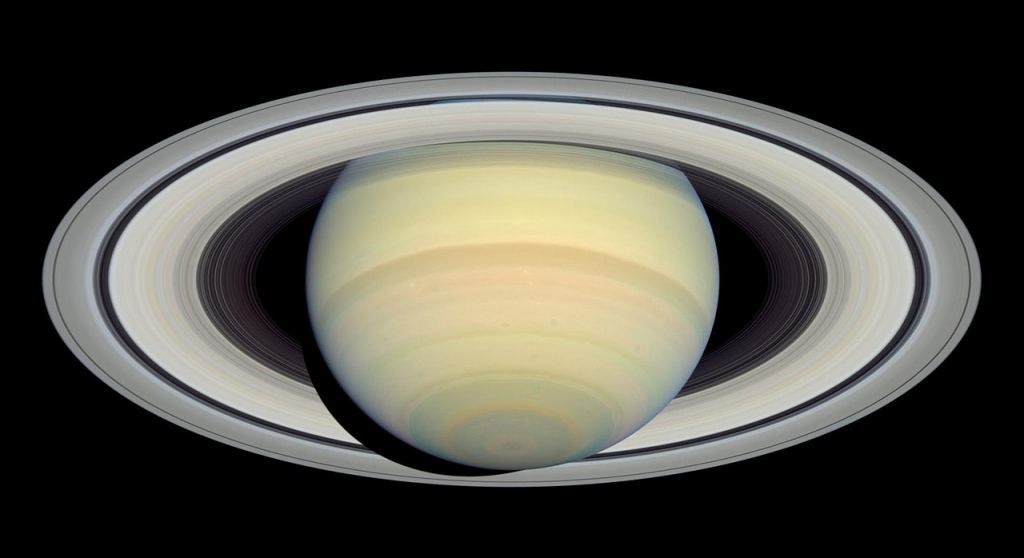When the name Saturn is uttered, what comes to mind? For most people, the answer would probably be, “its fabulous system of rings. ” There’s no doubt they are iconic, but what is perhaps lesser-known is that Jupiter, Uranus, and Neptune all have ring systems of their own. However, whereas Saturn’s rings are composed mainly of ice particles (making them highly reflective), Jupiter’s rings are composed mainly of dust grains.
Meanwhile, Uranus and Neptune have rings of extremely dark particles known as tholins that are very hard to see. For this reason, none of the other gas giants get much recognition for their rings. However, the question of why Jupiter doesn’t have larger, more spectacular rings than Saturn has been bothering astronomers for quite some time.
As the larger and more massive of the two bodies, Jupiter should have rings that would dwarf Saturn’s by comparison. This mystery may have finally been resolved thanks to new research by a team from UC Riverside. According to their study, Jupiter’s massive moons (aka.
Jupiter’s Galilean Moons) prevented it from developing a big, bright, beautiful ring system that would put Saturn’s to shame. The research was conducted by Stephen R. Kane, a professor of astronomy and planetary astrophysics with the Department of Earth and Planetary Sciences at UC Riverside, and his graduate student Zhexing Li.
The paper that describes their work, “The Dynamical Viability of an Extended Jupiter Ring System,” recently appeared online and is soon to be published in the Planetary Science Journal. As Kane stated in a recent article with UC Riverside News, the mystery of Jupiter’s missing rings is one he and Li were highly motivated to address. Illustration of Jupiter and the Galilean satellites.
Credit: NASA “It’s long bothered me why Jupiter doesn’t have even more amazing rings that would put Saturn’s to shame,” he said. “If Jupiter did have them, they’d appear even brighter to us because the planet is so much closer than Saturn. ” For their study, the team ran a series of dynamical N-body simulations that accounted for the orbits of Jupiter’s Galilean Moons (Io, Europa, Ganymede, and Callisto) and the availability of ring material.
Their results indicate that some of the icy material for Saturn’s rings may have come from comets, which were also responsible for distributing water to the planets of the inner Solar System billions of years ago. Jupiter would have been subject to the same level of comet activity in its early history, but the gravity of its massive moons was strong enough that they might have pushed this ice out of Jupiter’s orbit (or changed the orbit of the ice enough so that it collided with its moons). As Kane explained: “Massive planets form massive moons, which prevents them from having substantial rings.
We didn’t know these ephemeral rings existed until the Voyager spacecraft went past because we couldn’t see them. For us astronomers, they are the blood spatter on the walls of a crime scene. When we look at the rings of giant planets, it’s evidence something catastrophic happened to put that material there.
” While Saturn has many prominent moons of its own, only Titan rivals the Galileans in terms of mass. Eventhough that Saturn has 82 moons in orbit around it (that we know of), Titan accounts for 96% of their collective mass. While the gravitational interaction of these moons was enough to give Saturn its axial tilt (26.
73° relative to the Sun’s ecliptic), their combined gravitational force was not strong enough to prevent Saturn from accumulating icy material into a series of bright rings. Jupiter and its moon Europa are seen through the James Webb Space Telescope’s NIRCam instrument 2. 12-micron filter.
Credits: NASA, ESA, CSA, and B. Holler and J. Stansberry (STScI) Among the images recently released by the JWST, some showed Jupiter and its faint rings, which are more prominent when seen in infrared wavelengths.
This is one of many objectives of the Webb mission, which is to study the planets and moons of the outer Solar System. Using its advanced infrared cameras, Webb can spot faint ring structures and small objects around the gas giants that are hard to see in visible light. This is expected to yield valuable scientific returns, like telling us more about how planets in our Solar System formed and evolved.
Herein lies the value of studying planetary rings, where astronomers can learn more about the history of a planet because they are potential evidence of collisions with moons or comets that happened in the past. Their shape, size, and composition are all indications of events that might have led to their formation. Looking ahead, Kane plans to run simulations that address Uranus’ ring structure (smaller but more substantial than Saturn’s) to learn more about their history.
A popular theory is that the same impact that is believed to have knocked Uranus on its side led to these rings. The answer to this and other mysteries of planet formation and evolution will be the subject of considerable research in the coming years. The implications of these studies will go far beyond our Solar System and extend to the study of exoplanets, many of which are sure to have ring systems! For these distant worlds, the presence, size, and composition will provide clues about their formation and evolution.
Further Reading: UCR Riverside The post Jupiter’s Giant Moons Prevent it From Having Rings Like Saturn appeared first on Universe Today. .
From: universetoday
URL: https://www.universetoday.com/156887/jupiters-giant-moons-prevent-it-from-having-rings-like-saturn/



